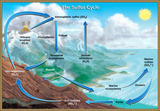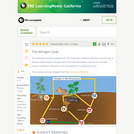
Introduction to how water, carbon, nitrogen, and phosphorus are cycled through ecosystems.
- Subject:
- Biology
- Ecology
- Life Science
- Material Type:
- Lesson
- Provider:
- Khan Academy
- Provider Set:
- Khan Academy
- Author:
- Sal Khan
- Date Added:
- 08/26/2016

Introduction to how water, carbon, nitrogen, and phosphorus are cycled through ecosystems.

Biology is designed for multi-semester biology courses for science majors. It is grounded on an evolutionary basis and includes exciting features that highlight careers in the biological sciences and everyday applications of the concepts at hand. To meet the needs of today’s instructors and students, some content has been strategically condensed while maintaining the overall scope and coverage of traditional texts for this course. Instructors can customize the book, adapting it to the approach that works best in their classroom. Biology also includes an innovative art program that incorporates critical thinking and clicker questions to help students understand—and apply—key concepts.


By the end of this section, you will be able to:Discuss the biogeochemical cycles of water, carbon, nitrogen, phosphorus, and sulfurExplain how human activities have impacted these cycles and the potential consequences for Earth


Ecology For All! Is an ecology text designed in modules so that instructors can choose the pieces that make sense to assign in their context. This book has been in development for several years and is a collaborative effort of authors at Gettysburg College, Franklin & Marshall College, and University of Pittsburgh. The textbook covers a wide range of topics including Introduction to Ecology, Evolution, Adaptations to the Physical Environment, various ecological communities, Population Ecology, Behavioral Ecology, Species Interactions, Ecological Succession, Biogeochemical Cycles, Landscape Ecology, Biodiversity, Conservation Biology, and Human Impact on Global Climate among others. The authors have presented on it at the Ecological Society of America meeting and the book continues to evolve.

This course provides an introduction to the atmospheric chemistry involved in climate change, air pollution and biogeochemical cycles using a combination of hands-on laboratory, field studies, and simple computer models. Lectures will be accompanied by field trips to collect air samples for the analysis of gases, aerosols and clouds by the students.

An integrated course stressing the principles of biology. Life processes are examined primarily at the organismal and population levels. Intended for students majoring in biology or for non-majors who wish to take advanced biology courses.
![Grassy Narrows and Muskrat Falls Dam: Hypothesis Testing and t-Tests [version 1.0]](https://oercommons.org/static/newdesign/images/materials/default-thumbnail-index.png)
Students are introduced to concepts of hypothesis testing using elementary hypothesis tests, t-tests, and p-values as they compare a given fish population for methylmercury levels (using real and hypothetical data) against real-world mercury standards.
![Grassy Narrows and Muskrat Falls Dam: The Central Limit Theorem and a t-test [version 2.0]](https://oercommons.org/static/newdesign/images/materials/default-thumbnail-index.png)
Students are introduced to concepts of sampling distributions and hypothesis testing using a simulation applet, elementary hypothesis tests, t-tests, and p-values as they compare a given fish population for methylmercury levels (using real and hypothetical data) against real-world mercury standards.

Students are presented with a guide to rain garden construction in an activity that culminates the unit and pulls together what they have learned and prepared in materials during the three previous associated activities. They learn about the four vertical zones that make up a typical rain garden with the purpose to cultivate natural infiltration of stormwater. Student groups create personal rain gardens planted with native species that can be installed on the school campus, within the surrounding community, or at students' homes to provide a green infrastructure and low-impact development technology solution for areas with poor drainage that often flood during storm events.

This resource is a video abstract of a research paper created by Research Square on behalf of its authors. It provides a synopsis that's easy to understand, and can be used to introduce the topics it covers to students, researchers, and the general public. The video's transcript is also provided in full, with a portion provided below for preview:
"Life in cold environments dominates Earth’s biosphere, where microbial activity plays a large role in biogeochemical cycles. 120 metagenomes from Ace Lake in East Antarctica were analyzed for a seasonal cycle and four summers over 10 years to determine how the polar light cycle affects microbial-driven nutrient cycles. The two most abundant taxa found were green sulfur bacteria (GSB) and cyanobacteria, both of which are highly influenced by light availability. Interestingly, the abundance of one important GSB member, Chlorobium, dropped significantly in winter before rebounding back to high levels in the spring. Although viruses specific for these microbes were abundant, the negative impact of viral infection on host growth appeared to be limited..."
The rest of the transcript, along with a link to the research itself, is available on the resource itself.

This resource is a video abstract of a research paper created by Research Square on behalf of its authors. It provides a synopsis that's easy to understand, and can be used to introduce the topics it covers to students, researchers, and the general public. The video's transcript is also provided in full, with a portion provided below for preview:
"Microorganisms are critical drivers of biogeochemical cycles and are the most abundant organisms in frigid regions. Identifying the genomic traits of cold-loving microbes may help explain their physiology and adaptation, but recognizing which genomic traits are important for environmental adaptation is challenging. A new study compared the genomes of Arthrobacter bacteria isolated from the Tibetan Plateau with published genomes of related bacteria and defined a new group of Arthrobacter that live in polar and alpine environments. In the laboratory, the bacteria in this group grew comparatively rapidly at 0 °C. Compared to bacteria from warmer environments, the polar/alpine bacteria had different genomic and amino acid compositions, and their predicted proteins had different stability levels and functions..."
The rest of the transcript, along with a link to the research itself, is available on the resource itself.

This course provides an introduction to the study of environmental phenomena that exhibit both organized structure and wide variability—i.e., complexity. Through focused study of a variety of physical, biological, and chemical problems in conjunction with theoretical models, we learn a series of lessons with wide applicability to understanding the structure and organization of the natural world. Students also learn how to construct minimal mathematical, physical, and computational models that provide informative answers to precise questions.
This course is appropriate for advanced undergraduates. Beginning graduate students are encouraged to register for 12.586 (graduate version of 12.086). Students taking the graduate version complete different assignments.
![Modified Grassy Narrows and Muskrat Falls Dam: Hypothesis Testing and t-Tests [version 2.0]](https://oercommons.org/static/newdesign/images/materials/default-thumbnail-index.png)
Methylmercury contamination within fish populations is an important toxin that affect human, animal, and environmental health, serving as a carcinogen (cancer-causing agent) and endocrine-disruptor (compounds that in some way alter the signaling of the hormone system. The impacts of exceeding safe dietary methylmercury levels were tragically made clear in Ontario, Canada, where a First Nations community in Grassy Narrows are living with the consequences of methylmercury poisoning in the fish supply. The fish were contaminated due to the dumping of mercury in the traditional waterways of the First Nation community. In 2016, there were highly publicized protests in Muskrat Falls, Labrador, Canada, where the Inuit people raised direct concerns about the potential for a proposed Nalcor Energy hydroelectric dam, to increase mercury levels in fish in those waters, which are an integral part of their traditional diet. Despite significant protests, the project was completed in 2019 and 41 km were flooded. This module uses these real-world examples as a jumping-off point for exercises that will guide case-study driven discussion on mathematical, biological and ethical concerns.
![Modified Grassy Narrows and Muskrat Falls Dam: Hypothesis Testing and t-Tests [version 3.0]](https://oercommons.org/static/newdesign/images/materials/default-thumbnail-index.png)
Methylmercury contamination within fish populations is an important toxin that affect human, animal, and environmental health, serving as a carcinogen (cancer-causing agent) and endocrine-disruptor (compounds that in some way alter the signaling of the hormone system. The impacts of exceeding safe dietary methylmercury levels were tragically made clear in Ontario, Canada, where a First Nations community in Grassy Narrows are living with the consequences of methylmercury poisoning in the fish supply. The fish were contaminated due to the dumping of mercury in the traditional waterways of the First Nation community. In 2016, there were highly publicized protests in Muskrat Falls, Labrador, Canada, where the Inuit people raised direct concerns about the potential for a proposed Nalcor Energy hydroelectric dam, to increase mercury levels in fish in those waters, which are an integral part of their traditional diet. Despite significant protests, the project was completed in 2019 and 41 km were flooded. This module uses these real-world examples as a jumping-off point for exercises that will guide case-study driven discussion on mathematical, biological and ethical concerns.

In this video from WOSU Columbus, learn about the types of communities of plants, animals, birds and fish that abound in wetlands.

Nitrogen, one of the most abundant elements in the universe, is essential to life. This interactive activity adapted from the University of Alberta provides an overview of the nitrogen cycle.

This resource is a video abstract of a research paper created by Research Square on behalf of its authors. It provides a synopsis that's easy to understand, and can be used to introduce the topics it covers to students, researchers, and the general public. The video's transcript is also provided in full, with a portion provided below for preview:
"Isoprene is the most abundantly produced biogenic volatile organic compound (BVOC) on earth.,with annual global emissions rivaling those of methane. Unfortunately, surprisingly little is known about how isoprene is degraded in the environment. A recent study reveals a new set of bacteria that can metabolize isoprene. Researchers used DNA isotope probing to study microbes that degrade isoprene derived from oil palm trees. Among the new genera they discovered were Novosphingobium, Pelomonas, Rhodoblastus, Sphingomonas and Zoogloea. Metagenomic analysis further demonstrated that oil palm soil harboured more and more-diverse isoprene-degrading bacteria than leaves. That finding suggests that oil palm soils could be a bigger sink for isoprene than previously thought. Understanding the distribution and identity of isoprene degraders in the environment is crucial. to determine the extent to which microbes mitigate the effects of this abundant but neglected climate-active gas..."
The rest of the transcript, along with a link to the research itself, is available on the resource itself.

This resource is a video abstract of a research paper created by Research Square on behalf of its authors. It provides a synopsis that's easy to understand, and can be used to introduce the topics it covers to students, researchers, and the general public. The video's transcript is also provided in full, with a portion provided below for preview:
"Every year, over 9 million metric tons of plastic waste enter the ocean and can harm its ecosystems. When it comes to marine microbes, most of the current research has focused on those that directly colonize the plastic particles. But plastic also leaches chemical additives into the water, which could impact planktonic microbes as well. So, researchers tested the impact of leachate from polyvinyl chloride (PVC), a common plastic, and zinc, a plastic additive, on a natural planktonic community. Some microorganisms, including both bacteria and eukaryotes, were impaired by exposure to plastic leachates. Photosynthetic microorganisms, the base of the food web, were particularly strongly affected, showing declines in photosynthetic efficiency, diversity, and abundance. Other important and normally highly abundant bacterial groups were also negatively impacted. In contrast, microorganisms that thrive in nutrient-rich environments, copiotrophs, dramatically increased in relative abundance..."
The rest of the transcript, along with a link to the research itself, is available on the resource itself.